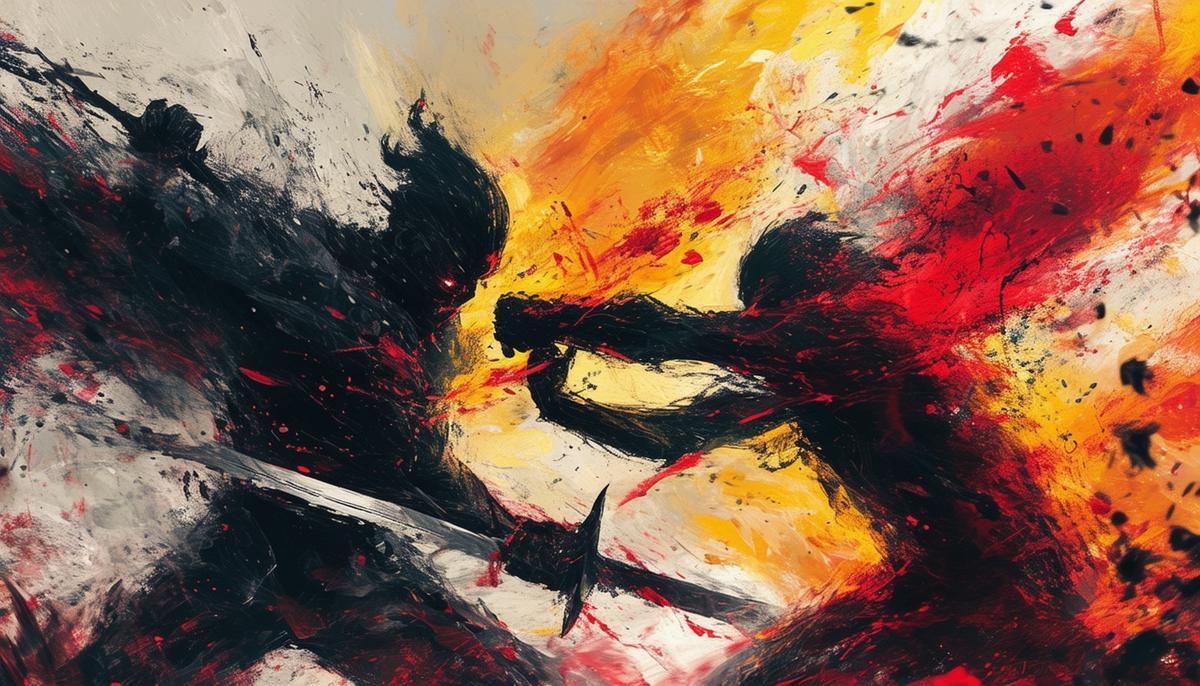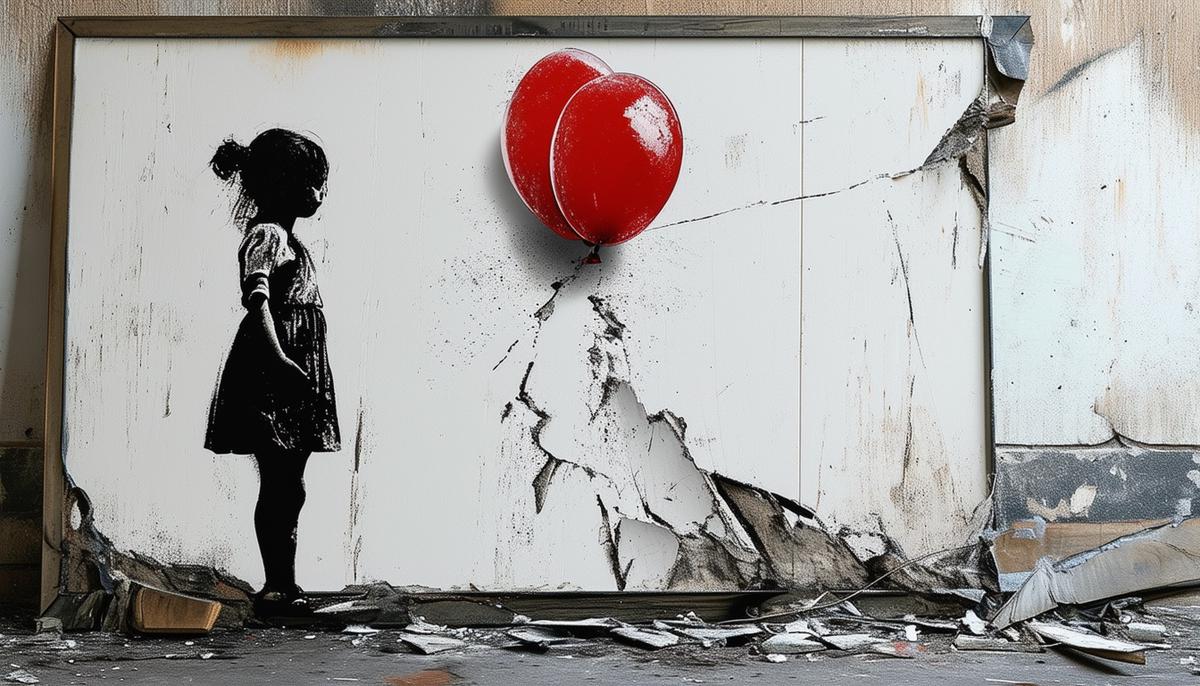1. The Art of Disappointment
Robert Nava: The Psychology of Ares (2022)
Robert Nava dives unabashedly into arenas others might avoid, breaching 'acceptable' art standards. His piece "The Psychology of Ares" catapults viewers into a chaotic brawl involving mythical misfits that appear to have leaped straight out of a fantastical sketchbook. This painting is admittedly messy, almost juvenile, yet therein lies its uncomfortable charm—perfectly enfolding in the blanket of what some might label the absolute breakup of high art etiquette.
Neil Jenney's Man and Machine (1969)
"Man and Machine" by Neil Jenney presents a roadside snapshot where tastes in art collide dramatically. The figures and vehicle resist harmony, featuring hurried swipes that might evoke a sense that Jenney wasn't just outside art's stylistic norms—he didn't even seek the address. It's a rejection of realistic precision and a salute to raw spontaneity. Here's where critics clutch their pearls and passersby may find unexpected kinship in its rough simplicity.
Cecilia Gimenez's Restoration of Ecce Homo (2012)
Famed more for the disaster it generated than the intention behind it, Cecilla Gimenez's "restoration" of Martinez's Ecce Homo fuels debates on the role of conservation. The mishmash repaint left the sacred depiction cartoonish. Etched now more profoundly in popular culture than originally intended, this "beast" of a restoration asks piercing questions about skills, intentions, and gatekeeping in art restoration.
The Undoing of St. George Statue (Estella, Spain)
The Estella St. George Statue faced a modern trial by brush, funded by misunderstood creative ambition. What was once a mighty representation got smudged into the realms of amateur art, shedding swordsman's prowess for an unsettling palette. More baffling, all elements of valor drowned by invasively chirpy colors, etching this scenario deeply into mishaps that echo.
Each piece dissents, contributing to the mosaic of artistic endeavors that accidentally plead for critics' attention, conversely opining what art ought not to be. This reverse-pleading ratifies viewers' allegiances or distastes, fixating spectatorship across spectrums – whether flunk or flourish, aptitude remains the eternal query.

2. Controversial Modern Art
Banksy's Shredded Painting (2018)
Banksy's dramatic intrusion during a Sotheby's auction is unforgettable. Moments after being sold, his famed Girl with Balloon started passing through a shredder hidden within the frame, half-destructing before a shocked live audience. Banksy's stunt re-frames concepts on material worth versus artistic intent. Is the resultant half-shredded work more valuable as a spectacle than it was as a stencil on canvas? This act challenges prevailing holdings in cultural and monetary valuation of art.
Jeff Koons' Balloon Animals (1990s-present)
Jeff Koons' Balloon Animal sculptures provide an interesting study in polarity. Wrought from polished stainless steel, these enormous pieces echo the transience of childhood delights through an indestructible medium. But is this art or exquisite craftsmanship exploiting nostalgia for profits? Critics argue both sides:
- Some view Koons' replicas as indicating a shallowness in contemporary art's validation.
- Yet, they prompt a broader demographic to interact with aesthetics in a space where whimsy meets wealth of execution.
These controversial pieces maintain a peculiar dance with audiences. Transporting beyond distaste and affection, they dwell in reactionary phases that underline notions about talent and artistic merit. The ambiguity or affront they represent to "norms" enable their controversy to dwell longer in institutional and public conversations, flickering on the edges of what's deemed admissible.

3. Historical Art Misinterpretations
In examining celebrated misfires and modern-day polemics, it becomes crucial to glean whispers from antiquated chronicles, shedding light on classical artworks once squinted at by their own time's eyes, morphing into triumph. The artwork whispers back a truth: initial folly and misunderstanding pave roads to eventual vindication.
J.M.W. Turner's Rain, Steam and Speed – The Great Western Railway (1844)
Turner thrust himself towards modernity with a depiction unsettling to Victorian sensibilities that prized clarity over the obfuscated swirls Turner paraded. The portrayal exhibits a locomotive as a streak of spectral impermanence, framed against nature's permanence. Initially received with stiff brows, Turner's visualization swirled slowly into recognition, redefining aesthetic seesaws.1
Edouard Manet's Olympia (1863)
Manet's Olympia fluttered immediate Victorian eyelids for all manners unconventional. The nude unnerved not for her lack of attire but by her confrontational gaze, challenging existent statutes on viewer and subject dynamics. The spread of disgust slowly gave way to convertible merits, proclaiming Olympia a rebellious mosaic and a defiant foremother sparking modernism.2
Pablo Picasso's Les Demoiselles d'Avignon (1907)
Upon its unveiling, Les Demoiselles d'Avignon faced cynicism at what was purportedly Picasso's dismantle of the feminine form through harrowing tribal masks and angular harshness. Time untangled this maze: Picasso's shard-like division represented monumental rifts from traditional views, herding faculties into cubist light fields and emerging planes. Viewer neurons, recalibrated, acceded this distorted ensemble as precursory shorthand of our frantic yet fractured reality.3
These transitions articulated through palette and framescape conducted historical dialogues where art was misunderstood, often retiring in the bohemian wilds of pre-maturity. As any inmate of time would fortuit, walls do crumble—launched by unsung ignominy paving strides toward admiration avenues winding and labyrinthine.
4. Technically Flawed Masterpieces
Michelangelo's The Last Judgment, painted on the Sistine Chapel's altar wall, pulls us into a vortex of tumultuous drama featuring over 300 figures. While undeniable in its mastery, this iconic fresco isn't free from technical discrepancies. Key is Michelangelo's contorted embodiment of figures:
- Limbs a bit too elongated
- Anatomies skewed with exaggerated musculature that refine his expressive, dynamic narrative intent
The vertigo of crowded scenes pulls perspective to wander amid heavenly cause.
Titian's Venus of Urbino showcases an alluring figure lying provocatively—an exhibition teeming in muted erotism; yet, herein lays an oddity:
- The anomalous rendering of her anatomically baffling right hand
- An inaccurate reclining posture
- Primarily argued is her torso too elongated
- Her left leg somehow melting into the foreground
Regardless, Titian's trip into these slips miscues not the tantalizing allegory he swathes Venus in.
Leonardo da Vinci's The Last Supper suffers not from compositional err but a failure in experimentation with technique. Leonardo's bold indulgence in substituting traditional fresco methods with an undercoat which incorporated tempera and metal foil led to accelerated deterioration; less than twenty years later the mural was flaking away.4 Here the defective methodology inscribes deeper valuation scales weighing technological gusto against surviving proportions of decay.
Botticelli's The Birth of Venus also plays proportions liberally—Venus herself stands on a shell, both elongated and oddly structured which seems barely capable of supporting her delicate stance. The Zephyrs to her left blow wind that anatomically arcs improbably in physical relation to their shown effort. The commingled charm and error serve enriched suspense, notably in how her ambiguous aloofness overlooks technical judgements to maintain artistic hypnotism.
These instances spill over value not merely confined within their epoch-inducing realms but played futurology with defiant borrowed anatomy placed amidst the fervor and canon of Renaissance artistry—manifest against critic spark where flame tidings ramble towards eternity's acclaim.

5. Art that Divided Critics
In the colorful panorama that is the art world, few things ignite as passionate debates as spectacularly divisive artworks. Below, explore a diverse collection of works whose reception split galleries, scholars, and the public into frenzied factions, leaving a complex legacy enmeshed primarily with critical reception.
Salvador Dalí's Lobster Telephone (1936)
Dalí's Lobster Telephone combines the mundane with the bizarre, joining a sizeable lobster to a telephone. Detractors viewed it as frivolous and perplexing—a forced marriage of imageries serving kitsch. Others applauded Dalí's idiosyncratic symbol for eliciting erotic connotations and challenging norms of comfort and functionality. This telephone clattered critiques about Dali's sincerity, continually rediscovered as a guide to avant-garde providence amidst bourgeois communication.
Anish Kapoor's Cloud Gate (2004)
Kapoor's Cloud Gate initially divided opinion due to its striking simplicity and large footprint in Chicago's Millennium Park. The sculpture played with perceptions of what public art must represent, veering between all-consuming narcissism to fearless felicity among visitors. Over time, though, its lucrative selfie altar reached a profound equilibrium, engendering Kapoor's erudite smile over diluted qualms.
Marcel Duchamp's Fountain (1917)
By subverting classical art sentiment and submitting a urinal signed "R. Mutt" for exhibition, Duchamp's Fountain incited a regulatory cataclysm. Critics bombarded it with epithets ranging from mindless nihilism to dauntless anti-art, catalyzing legions of subsequent boundary-pushing expressionists. Fountain tossed the status values reciprocal among artistic treatises to see whether anything at rock bottom wasn't purposefully artistic.
Yoko Ono's Cut Piece (1964)
Ono's performance art in Cut Piece implored audience members to cleave away her garb, challenging prevailing notions of personal space, consent, vulnerability, and participation. Onlookers were decidedly split—some viewed it as inherently abusive, while others saw it as a transcendental liberation, slicing societal veneers to humane contact's core.
Damien Hirst's Mother and Child Divided (1993)
Hirst presented his dissected bovine and calf in formaldehyde at the Venice Biennale. The aesthetics distilled either sterile cynicism or profound meditations—punctures of germinating biological translations beyond average beholder capacity. His aesthetic intent was seen as either gratuitous or an intellectual embrasure, forcing uneasy reflections on life-death dynamics made visible.
Each contentious artwork, through radical concept or execution, provoked tides that soured as frequently as swirled patrons lavish—parleyed cultural precipices that affirmed or denied aesthetic attributes. These wrangles apportion critical alloys across market values—a context engraved by every critic opening rail for sustained discourse.

Ultimately, the essence of controversial art transcends mere visual appraisal; it challenges viewers to confront their biases and engage with deeper societal questions. The most provocative artworks capture attention and compel a reevaluation of what art can be—a dialogue continually reshaped by each bold stroke and audacious installation.























